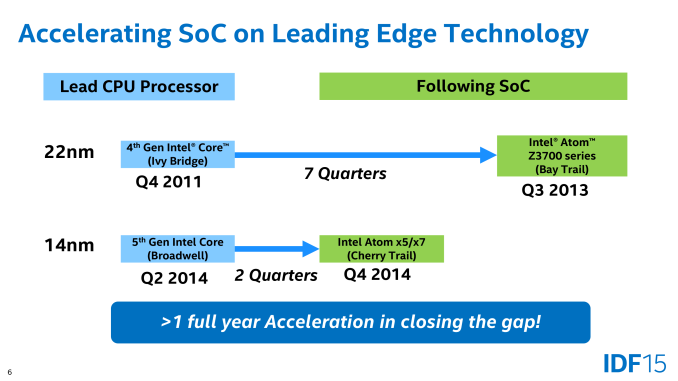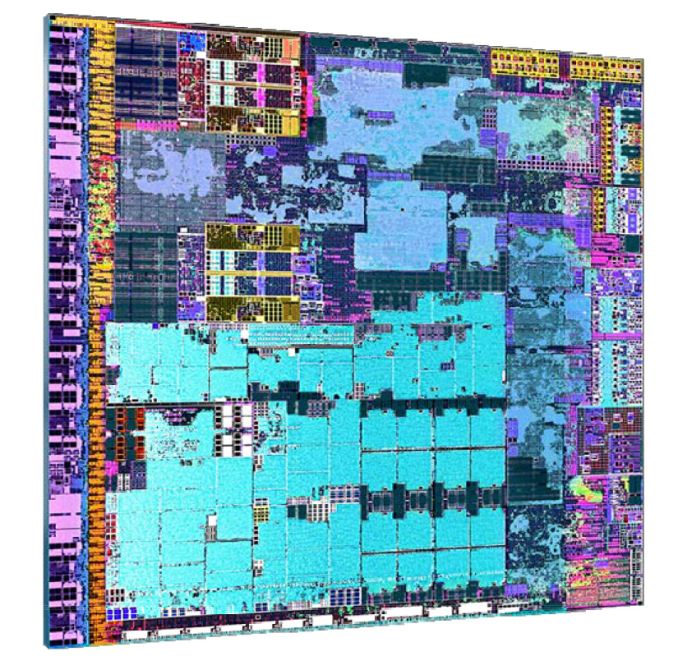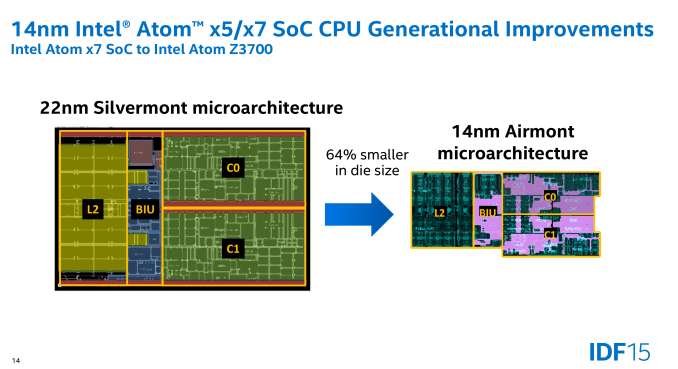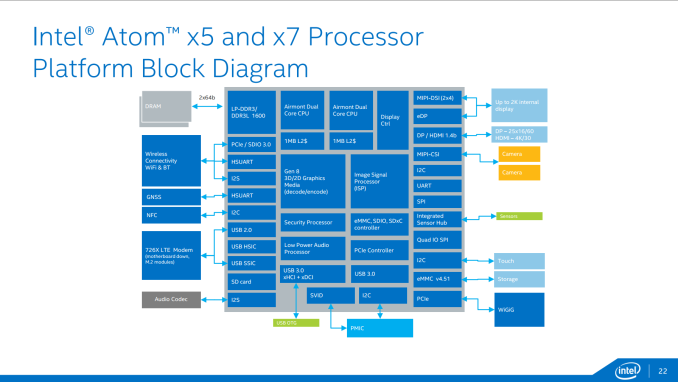The Surface 3 Review
by Brett Howse on May 4, 2015 9:00 AM ESTPowering the Surface 3: Intel’s Atom x7 System on a Chip
I still remember when back in 2011 Intel announced that they were finally going to stop treating Atom as a second class citizen at the manufacturing level, and bring it in line with the company’s mainstream Core processors. After having drawn out the 45nm and 32nm Atoms for too long, and suffering in the marketplace versus ARM as a result – Intel realized that to combat the growing threat of ARM they would need to treat the mobile market more seriously, and they would need to commit their sizable manufacturing advantage to the field to do this.
Now even Intel can’t turn on a dime – processors design begins half a decade in advance these days – so what have seen is a gradual ramping up towards this point. Silvermont, Intel’s first 22nm Atom, would introduce a more modern and better performing out-of-order architecture for Atom, meanwhile Intel would catch up on the manufacturing side by not producing 2 generations of Atoms on the 22nm node. Instead Silvermont would be the only 22nm Atom, and was to be followed by 14nm Airmont roughly a year later.
With Intel’s initial 14nm problems that year later ended up being a bit longer than a year, but in 2015 we’re finally there, and the change is remarkable. Only one generation ago, Intel launched their 22nm process as they always do, with desktop and high-performance laptop processors first. Now with 14nm the tables have been turned; Atom didn’t get first-dibs on 14nm – that went to Core M – but Airmont is still going to beat Intel’s desktop and high-performance Broadwell SKUs to the retail market. In one generation Intel has gone from favoring the desktop to favoring mobile, that’s how serious Intel has become.
That brings us to Surface 3, and the SoC powering it: Cherry Trail. The successor to the Silvermont-based Bay Trail that has powered so many x86 tablets in the last year, Cherry Trail is a distinct tick in Intel's tick-tock cadence. What this means is that Intel has largely retained the same architecture as in Bay Trail, investing in a fairly small number of updates, looking to take advantage of the power consumption and die size (cost) benefits of 14nm. To that end Intel has not even bothered to announce any major architectural changes for Airmont, and while there will likely be a few tweaks made to the CPU to make it work more efficiently on 14 nm, we will have to wait for Goldmont for the next big Atom architecture.
Cherry Trail itself is a fairly small chip. While Intel hasn’t released an official die size for it (no more than they did Bay Trail), from various IDF presentations they have released official numbers for the complete package, and decent photos as well. As a result we can take a decent stab at die sizes, and from Intel’s photos we’d estimate that the die size is around 83mm2. Unfortunately we don’t have anything quite comparable to Bay Trail, though we believe it to be a good bit smaller than Intel’s previous generation tablet SoC. At 83mm2 this would put the die size at quite a bit smaller than Apple’s A8X tablet SoC, and actually is just a hair smaller than the A8 phone SoC’s 89mm2.
Diving a bit deeper, Intel has also released some size data for individual Silvermont/Airmont CPU modules. The dual core modules, which contain the 2 CPU cores along with L2 cache and appropriate glue, have shrunk significantly from Silvermont to Airmont. Overall the Airmont CPU module is 64% smaller than the Silvermont module. And to be clear that does not mean Airmont is 64% of the size of Silvermont, that means that Airmont has been reduced by 64%; relative to Silvermont it is only 36% of the die size. Intel has achieved a better scaling factor than 22nm to 14nm alone, indicating that they have almost certainly enacted further optimizations to bring down the die size as an architectural level.
Moving on to the architecture of Cherry Trail, each Airmont core is a two-wide instruction decode with out of order execution. The L1 cache is 32 KB 8-way associative for instructions, and 24 KB 6-way associative data cache. Level 2 cache is 16-way associative with 1 MB of cache shared between two cores. There will be either two or four core versions available, which means that each SoC will have between 1 and 2 MB of L2 cache depending on the number of cores. There is no L3 cache on Atom.
The System on a Chip (SoC) has support for LP-DDR3 or DDR3L 1600 in dual-channel configuration, and has the blocks needed for PCIe 3.0, USB 2.0, USB 3.0, and support for up to three displays with eDP, DP, and HDMI 1.4b. The built in storage support is eMMC v4.5.1, which is typical for a tablet class processor.
Here is a Block Diagram of the SoC.
The one truely major change to the SoC is the inclusion of Intel's Gen 8 Graphics. Bay Trail used Gen 7 Graphics from Ivy Bridge, and Bay Trail only had 4 Execution Units (EUs) available. Cherry Trail ramps that up significantly, with the latest Gen 8 Graphics from Broadwell now onboard, bringing forward Intel's GPU enhancements over the last two half generations, not to mention the compute enhancements as well.
In terms of execution hardware the x7-8700 model has 16 EUs available, indicating that Intel has spent a significant amount of their die size savings from the 14nm process on graphics resources. Gen 8 has eight EUs per sub-slice but a minimum of three sub-slices in the design, and therefore in order to improve SoC yields the thread scheduler will dynamically allocate the right amount of cores per-subslice to total 16. For comparison, Intel's Broadwell line of Core processors have a minimum of 23 (but most have 24) EUs available, and a maximum of 48, so with Cherry Trail Intel has closed the top-to-top gap in execution resources between Core and Atom to just 3-1.
In Intel’s datasheets, the Atom GPU is labeled as Gen8-LP to designate that this is a low power model being used in a tablet. The base frequency for this GPU is 200 MHz, with a boost of 600 MHz.
In addition to the GPU update, the ISP and hardware decode capabilities get a bump as well. There is full hardware acceleration for decode of H.263, MPEG4, H.264, H.265 (HEVC), VP8, VP9, MVC, MPEG2, VC1, and JPEG, as well as hardware encode for H.264, H.263, VP8, MVC, and JPEG. This marks the first Intel product to ship with the company's full, fixed-function HEVC decoder, making Atom the company's most advanced media processor, at least for this short moment.
The overall SoC is 17mm x 17mm, and the Z-height is 0.937mm, so it is quite a bit smaller than Core M’s 30mm x 16.5mm x 1.05mm package. Intel is not listing a Thermal Design Power for the Atom chip, but is instead listing it as a Scenario Design Power of 2 watts. The CPU base frequency is 1.6 GHz with a turbo frequency of 2.4 GHz, and there is also support for a Low Frequency Mode of just 480 MHz for extra power savings when needed.
| Atom x7-8700 | Atom Z3785 | |
| Architecture | Cherry Trail (Airmont) | Bay Trail (Silvermont) |
| Cores / Threads | 4 / 4 | 4 / 4 |
| Base Frequency (MHz) | 1.6GHz | 1.5GHz |
| Turbo / Burst (MHz) | 2.4GHz | 2.4GHz |
| L2 Cache | 2 MB | 2 MB |
| SDP | 2 W | 2.2 W |
| GPU Architecture | Gen 8 | Gen 7 |
| GPU Execution Units | 16 | 4 |
| GPU Frequency / MHz | 200-600MHz | 313-833Mhz |
| DRAM | LPDDR3-1600 | LPDDR3-1333 |
So what we really have here is a massaged Bay Trail class chip, but the 14 nm process should allow for a higher period of sustained turbo frequencies to help out with performance. It will be interesting to see what Intel does with Goldmont, and if they will add things like hyper-threading or not, but that discussion is for another time.
















265 Comments
View All Comments
MrTetts - Tuesday, May 5, 2015 - link
The IPad is ALWAYS going to be an inferior product regardless of use case.1. For video/media consumption - you would have access to more media players, more content markets (than just the itunes store) and simply more choice overall.
2. For media/content creation - You do not even have this option (or intergrated well enough) on an IPad.
3. Basic office duties - We can all agree that any office applications on an IPad would be very watered down and frankly quite useless. If you have to buy a keyboard to access an application properly on an ipad, then my friend, I have news for you... your use case clearly aligns you to a surface 3.
An IPad is no where near up to par. You are getting a very big IPod Touch for your money. Don't give in to the marketing from Apple telling you you can be productive on an IPad.
zhenya00 - Tuesday, May 5, 2015 - link
No, just no. I could make a list 3 times as long as yours detailing the ways that an iPad is superior to any Windows tablet. And I own several iPads and two Surface Pros. Frankly I'm just tired of having to counteract this kind of FUD.romprak - Tuesday, May 5, 2015 - link
I have 3 iPads at home (first gen, 3rd gen, and Air) - and his list seems quite accurate to me. One reason I've started transitioning our children after they are 6 years old to Surfaces and/or Macs. I am a little sad at how much money we've wasted on iPads, I certainly will not be doing that any longer.With our Macs and Surfaces, the children are actually learning how to do stuff and not be passive observers.
lolstebbo - Tuesday, May 5, 2015 - link
The only mental block I'm having right now is does Microsoft even have some sort of equivalent to iMovie? That's the one thing on the Mac side that I don't have a Windows-compatible equivalent for.lilmoe - Monday, May 4, 2015 - link
Better performance is arguable. Your mileage may very when it comes to battery life too. It's not only about the keyboard, it's what you can do with that keyboard (IE: iOS VS full Windows, and there's not comparison there). With Windows 10, it's practically game over when it comes to value.It's the other way around. The iPad, and other Android tablets (I'm looking at you Samsung), should be priced way less if we're talking "value".
pedromcm.pm - Monday, May 4, 2015 - link
No. The iPad has better screen, apps designed for that screen, a much superior touch-based ecosystem, better SoC performance, 4g option, better battery life and so on. And people buy it because it doesn't run windows, too... It runs something else that is fun, simpler, and does the job, most of the time.Still, i hope that with force touch Apple brings a superior pen-based solution. Because of the mentioned qualities, if the iPad adds what is seen as the surface and note line greatest advantages, it will be the equivalent of iPhones and bigger screens.
ultrAV - Monday, May 4, 2015 - link
"apps designed for that scren" what do u mean, are you compare ios to android tablet?4g option is available for surface 3 too
BlueBomberTurbo - Monday, May 4, 2015 - link
Better screen? Might want to read over the Display section again...Considering the lightweight OS, it's no wonder the iPad has better performance. Try running OS X on there and see what happens.
The Surface 3 will also have a 4G option soon, just not at launch.
And Windows 10 will be able to run fun and simpler apps from iOS and Android, and apps that always get the job done from Windows. ;)
pSupaNova - Monday, May 4, 2015 - link
Please guys this tablet can not compare itself to an IPad or Android in the tablet space.Simple things like finding good replacement soft keyboards are severly lacking in the Metro store.
The performance of the atom is getting better as the GPU has vastly improved but cannot still match last years top tablets.
As for Full windows use your better off just getting a laptop, the included digitizer is a very good addition but thats a niche field at best.
Microsoft need to drastically lower the price of this tablet if they want it too succeed or throw in the touch cover and pen.
And trying to intice Android and IOS developers is just showing how lacking Windows store is.
Lesliestandifer - Monday, May 4, 2015 - link
I have an iPad can't really compare windows to iOS or android. When I want do some reading in bed I reach for my tablet when I want to do some real work I get my pc. Both iOS and android flourished because they were cheap quick n easy and there was really no Windows alternative with equivalent specs and power. No one said the windows store was awesome I also had a windows phone it sucks.tablets have always left me wanting to be able to do more. iPads are significantly underpowered and still don't multitask properly! Now with the opportunity to get rid of the iPad\laptop and run it from one device ....yes I will be doing that when the SP4 comes out.